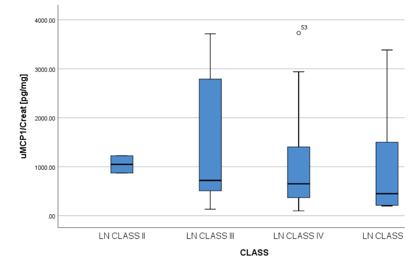Session Information
Date: Sunday, October 21, 2018
Title: Systemic Lupus Erythematosus – Clinical Poster I: Clinical Manifestations and Comorbidity
Session Type: ACR Poster Session A
Session Time: 9:00AM-11:00AM
Background/Purpose: Lupus Nephritis one of the commonest manifestations of SLE. Despite being the gold standard in Lupus nephritis, renal biopsy is an invasive procedure with potential complications and difficult to repeat. Current treatment guidelines prioritize the histological class of lupus nephritis. Monocyte chemo-attractant Protein-1 (MCP-1) a chemokine produced locally during active nephritis was shown in many previous studies as a promising biomarker for activity. This study investigates its usefulness to define histological classes.
Methods: This is a case-control study conducted at a tertiary care center in North India. Cases were patients of SLE satisfying the criteria for active lupus nephritis, defined as proteinuria> 1 gm/24 hours and/or active sediments in the form of hematuria [RBC > 5/hpf] or presence of cellular casts and undergoing kidney biopsy (n=36). Controls were patients of SLE without active LN (less than 500 mg/24 hours proteinuria and no active sediments. These were further divided into Control group I, those who had previously had lupus nephritis and were treated (n=11) and Control group II, those who never had nephritis (n=15)]. Urinary MCP-1 measurement was done using Sandwich ELISA kit. This was normalized for urinary creatinine excretion (pg/mg).
Results: Mean age in cases was 31.1±10.2 years and in control-I was 34.6±8.0 and control II was 36.3±10.4 yrs respectively (p=0.3). Urinary MCP-1 values in cases (1214 ± 1467.1 pg/mg) were significantly higher compared to controls (184.5±186.8 pg/mg, p<0.001). However, no significant difference was observed between control group I (170.5±150.8) and control group II (194±214, p=0.7). Urinary MCP-1 levels showed significant correlation when compared with classical disease markers like 24-hour proteinuria, 24-hour PCR, Spot PCR and SLEDAI. A cut off value of MCP-1 of 339 pg/mg on ROC curve has sensitivity and specificity of 80% and 92% respectively for differentiating active from inactive nephritis. However, there was no significant difference of Urinary MCP-1 levels among different classes of nephritis (p=0.593) (Figure 1). Urinary MCP-1 levels did not show significant correlation with Renal activity index calculated on renal biopsy.
Conclusion: Urinary MCP-1 was not associated with different histological classes of lupus nephritis.
Figure 1: Box-plot depicting Urinary MCP-1 (normalized to urinary creatinine) across various histological classes. Box-plots show median and interquartile range, whiskers denote 1.5xIQR 
To cite this abstract in AMA style:
Dhir V, Gone RK, Sandhu A, Sharma A, Sharma S, Nada R, Jain S, Rathi M. Can Monocyte Chemo-Attractant Protein-1differentiate Different Histological Classes in Lupus Nephritis? [abstract]. Arthritis Rheumatol. 2018; 70 (suppl 9). https://acrabstracts.org/abstract/can-monocyte-chemo-attractant-protein-1differentiate-different-histological-classes-in-lupus-nephritis/. Accessed .« Back to 2018 ACR/ARHP Annual Meeting
ACR Meeting Abstracts - https://acrabstracts.org/abstract/can-monocyte-chemo-attractant-protein-1differentiate-different-histological-classes-in-lupus-nephritis/
